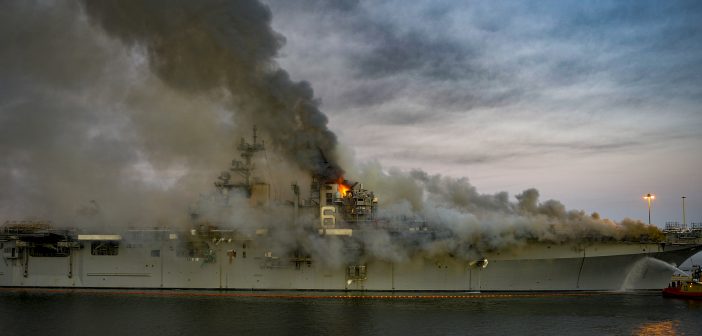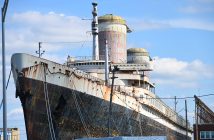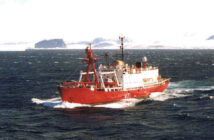Updated at 1730 EDT on 16 July 2020
The fire aboard the US Navy amphibious assault ship Bonhomme Richard in San Diego raises profound questions about the competence and capacity of the service and its leadership — with budget, strategy and deterrence implications.
The world rightly is asking how a warship that could cost $4 billion to replace can catch fire at a major naval base and burn out of control for days.
The accident is the latest in a series of incidents over the past several years that has included the Fat Leonard scandal, deadly collisions, acquisition missteps and the sidelining of USS Theodore Roosevelt earlier this year that ended up costing the ship’s captain, the strike group commander and ultimately the acting Navy secretary their jobs.
While the TR episode gave the Navy a black eye, the Bonhomme Richard fire has left many asking the same questions after the 2017 collisions — how the Navy will perform in war if it can’t operate without costly accidents in peace, and whether there is a deeper underlying problem that links these seemingly disparate events?
The fire comes as the unique capabilities Bonhomme Richard and its 10 sisterships are vitally needed to project reassuring and deterrent force across the Pacific as China becomes increasingly aggressive. And she recently underwent a costly upgrade to become one of four “Lightning Carriers” equipped to carry the US Marine Corps’ new F-35B fighters.
Aside from operational and reputation repercussions, the fire undermines the Navy’s case for more ships. Defense officials and lawmakers already skeptical of the Navy’s performance will ask why it needs more ships if it can’t take care of the ones it already has. Repairing or replacing her will take resources from other priorities as defense spending flattens and national priorities change.
Moreover, how will allies and potential adversaries regard the Navy’s ability to deter, defend and reassure?
An investigation into the fire will determine what happened aboard the ship and valuable lessons will be learned.
That investigation will reveal why welding was reportedly being performed early on a Sunday morning when the ship’s automatic firefighting systems were off line. Why were personnel reported to have evacuated the ship after a 55-gallon drum exploded rather than redouble efforts to extinguish the fire before it got out of control? It will ask what role civilian firefighters, base and shipyard personnel or contractors played as well as why more resources weren’t drawn more quickly from across the base to fight the fire. The investigation will likely hold the captain and members of his crew as well as his superiors accountable and propose changes to in-port watch sections and fire standards.
Sadly, Navy investigations tend to be narrowly focused and punish those directly involved while absolving the most senior leadership rather than determine whether there are broader factors at play. Such was the case in the TR incident. The Navy punishes individuals allowing the institution itself to avoid responsibility and culpability.
All organizations are about people. In any effective organization, leaders are ultimately responsible for their people.
During his confirmation hearings, Navy Secretary Ken Braithwaite described the “failure of naval leadership,” which he later amended to mean the service’s civilian leadership. However, it would appear that this condemnation also applies to the uniformed side.
To investigate 2017’s ship collisions then Navy Secretary Richard Spencer created an outside panel that was far more critical and wide reaching than the Navy’s formal review.
As the Navy moves to investigate this fire, it’s critical that leaders take a broader look at leadership, organizational, operational and cultural factors that may be at the heart of missteps. It’s time for deep soul-searching that is long overdue.
If that review is launched by the Chief of Naval Operations, Adm. Mike Gilday, it will be far more effective than if it is imposed on the service by DoD, the Hill or the White House. Braithwaite, however, should consider an external review of his own.
Over the years, a passionate debate has raged whether these episodes have a wider underlying cause and if so, what they are.
Some argue against a rush to judgment, stressing that accidents happen. That the Navy remains a singularly able force providing high-demand capabilities to deter adversaries. A fire that would easily have been extinguished by a ship fully manned at sea simply got out of control in port with only 160 sailors aboard.
Others, however, maintain that the common thread appears to be failures in basic leadership, management and judgment at the highest level, leaving the impression the Navy is not ready for prime time.
That means asking hard questions that can no longer be ignored, dismissed or swept under the rug.
There is no doubt that the Navy is the world’s most powerful thanks to extraordinary people who work hard every day to do the right thing. But failures born of lapses of judgment painfully suggest it may not be as good as it thinks it is or needs to be.
There is a fine line between confidence stemming from demonstrated capability and overconfidence that may be misplaced. As tensions with China rise, it’s imperative the Navy identify its weaknesses before a determined and focused adversary exposes — or worse, exploits — those weaknesses under fire.
Is the problem arrogance born of the service’s perception that it’s the best navy in the world, thereby breeding overconfidence and pernicious complacency? Has the US Navy that last saw high-end warfighting success in World War II become a victim of its own image as did the Royal Navy in the century after Trafalgar?
Are senior leaders out of touch with the force, talking in lofty terms about warfighting capabilities to sailors who sense that flag officer rhetoric doesn’t match their deck-plate reality? Could an aversion to risk to avoid career-ending mistakes be a factor? Or is it a bipolar culture that encourages rule-breaking, but harshly punishes those who are caught breaking those rules?
Is it that the Navy, unlike its sister services, is not one force, but a collection of forces with sometimes conflicting and blurred lines of control that make real authority and accountability virtually impossible?
Or is one of the causes a force that’s busier than ever, trying to do more with less, cutting corners to keep getting the job done, like rushing work on a Sunday morning to get a ship that was late out of the yard back in service as quickly as possible?
If the Navy is to be seen as a serious organization, it must confront the reality that all is not well. Its deterrent abilities depend on convincing adversaries in Beijing, Moscow, Pyongyang or Tehran that it’s so formidable and competent that no one would risk confronting it.
These accidents and incidents undermine the Navy’s ability to project an image of invincibility and have no doubt prompted adversaries to see weakness and opportunity.
The loss of such an important fleet unit is a tragedy. But the real tragedy will be if the Navy treats this incident as it does every other one — that it was a one-off lapse in judgement rather than something that may have far deeper underlying cause.





1 Comment
Pingback: The US Navy Must Soul-Search in Wake of Bohonmme Richard Fire | taktik(z) GDI (Government Defense Infrastructure)